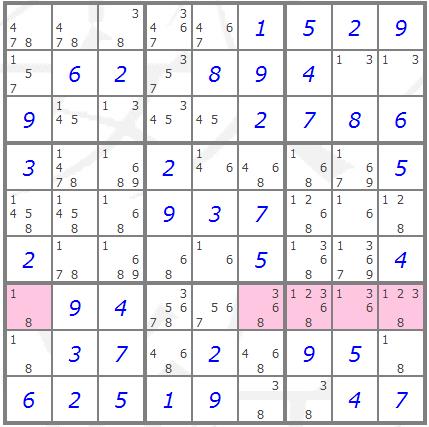Naked Single
The "naked single" solving technique also known as "singleton" or
"lone number" is one of the simplest Sudoku solving techniques.
Using this technique the candidate values of an empty cell are
determined by examining the values of filled cells in the row,
column and box to which the cell belongs. If the empty cell has just
one single candidate value then this must be the value of the cell.
In the example below, if you examine the values of the filled
cells in the same row, column and box as the highlighted cell you
can see that the highlighted cell has only a single candidate value
since all other possible candidate values are already used.
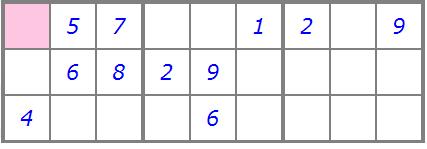
To illustrate this more clearly the same example with candidate
values in empty cells is shown below, as you can see the highlighted
cell has a single candidate value.
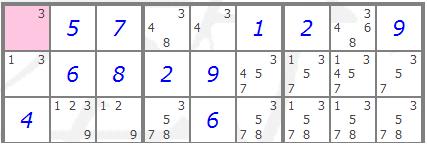
Naked Pair
The "naked pair" solving technique is an intermediate solving
technique. In this technique the Sudoku is scanned for a pair of
cells in a row, column or box containing only the same two
candidates. Since these candidates must go in these cells, they can
therefore be removed from the candidate lists of all other unsolved
cells in that row, column or box. Reducing candidate lists may
reveal a hidden or naked single in another unsolved cell, generally
however the technique is a step to solving the next cell.
The highlighted cells in the example below show a naked pair
containing the candidate values (2,3) in the third column. Since
this is a naked pair the candidate values can be removed from all
other unsolved cells in the column. This reveals a second naked pair
containing the candidate values (7,9) in the same column. Reducing
the candidate lists of other unsolved cells in the same box reveals
a naked single.
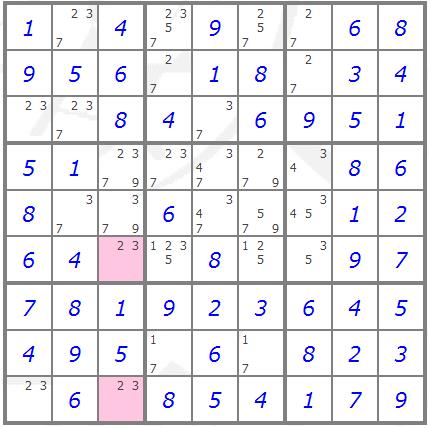
Naked Triple
The "naked triple" solving technique is similar to the naked pair solving technique described above.
In a naked triple, three cells in a row, column or block contain
some combination of the same three candidates. Each individual cell
in the naked triple does not have to contain all three candidates
however. In fact it is perfectly legal for each individual cell to
have only two of the three candidates.
The highlighted
cells in the example below show a naked triple containing the
candidate values (2,4,7) in the centre box. These candidate values
can be removed from all other unsolved cells in the box. This
reveals a naked pair containing the candidate values (3,5) in the
central row of the same box. Reducing the candidate lists of other
unsolved cells in the same row reveals a naked single in that row.
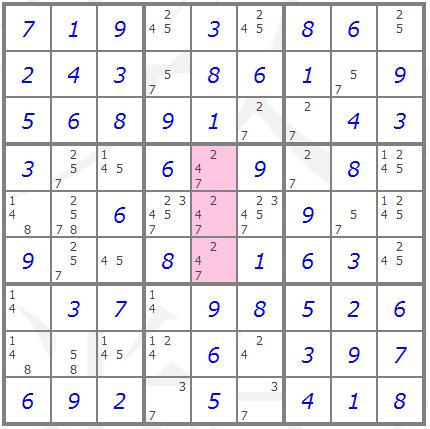
Naked Quad
The "naked quad" solving technique is similar to the naked triple solving technique described
above. In a naked quad, four cells in a row, column or box contain
some combination of the same four candidates only.
The
highlighted cells in the example below show a naked quad containing
the candidate values (1,7,8,9). These candidate values can be
removed from all other unsolved cells in the box. This reveals a
naked pair containing the candidate values (2,6) in the bottom row
of the same box. Reducing the candidate lists of other unsolved
cells in the same row reveals a naked single in that row.
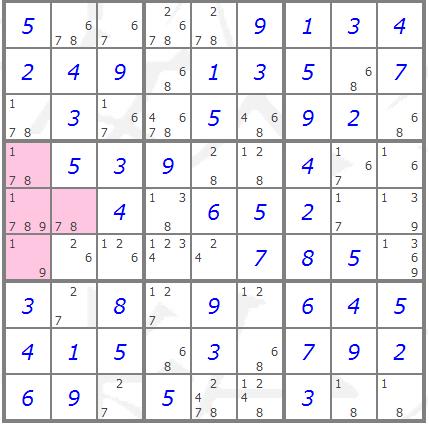
Naked Quint
The "naked quint" is the final solving technique in the naked subset
series and is similar to the naked triple
solving technique described above. In a naked quint, five cells in a
row, column or box contain some combination of the same five
candidates only.
The highlighted cells in the example
below show a naked quint containing the candidate values
(1,2,3,6,8). These candidate values can be removed from all other
unsolved cells in the row. This reveals a naked pair containing the
candidate values (5,7) in same row.
